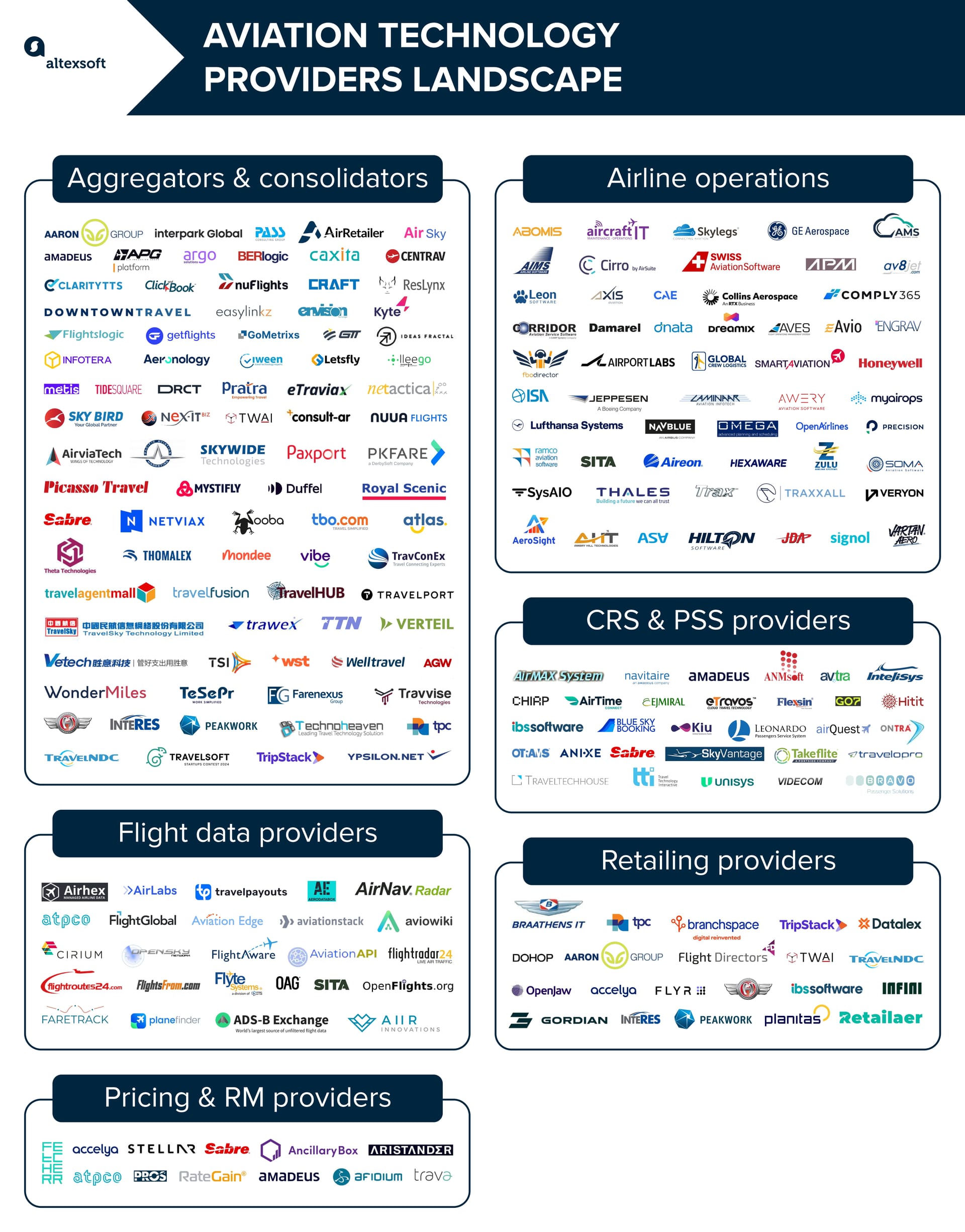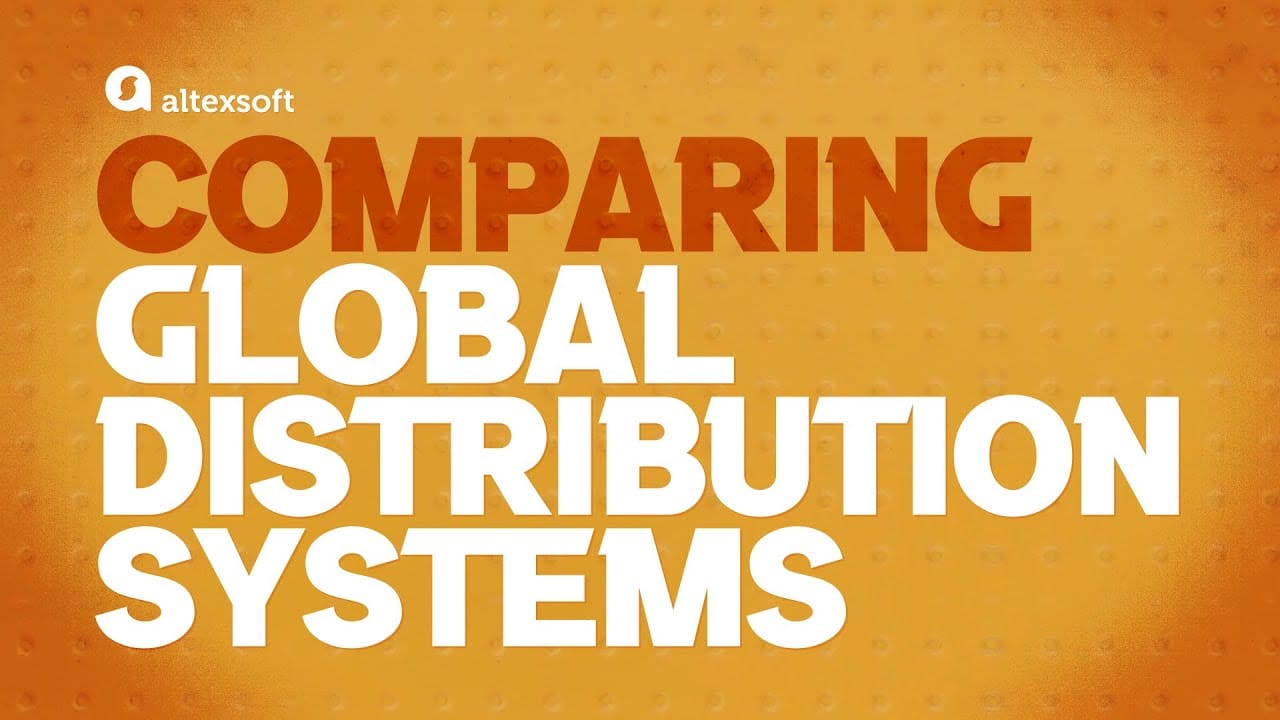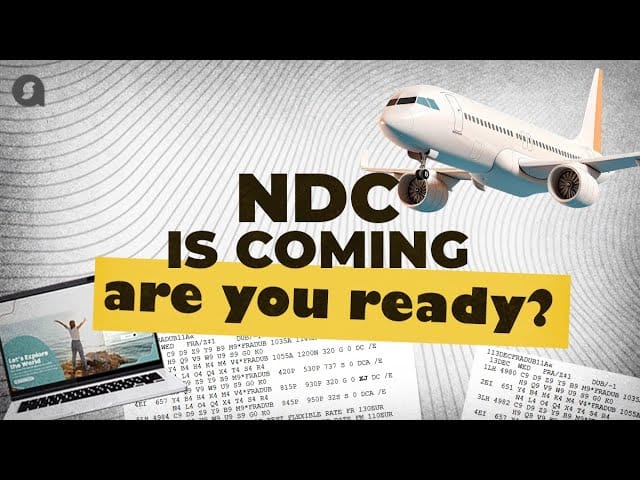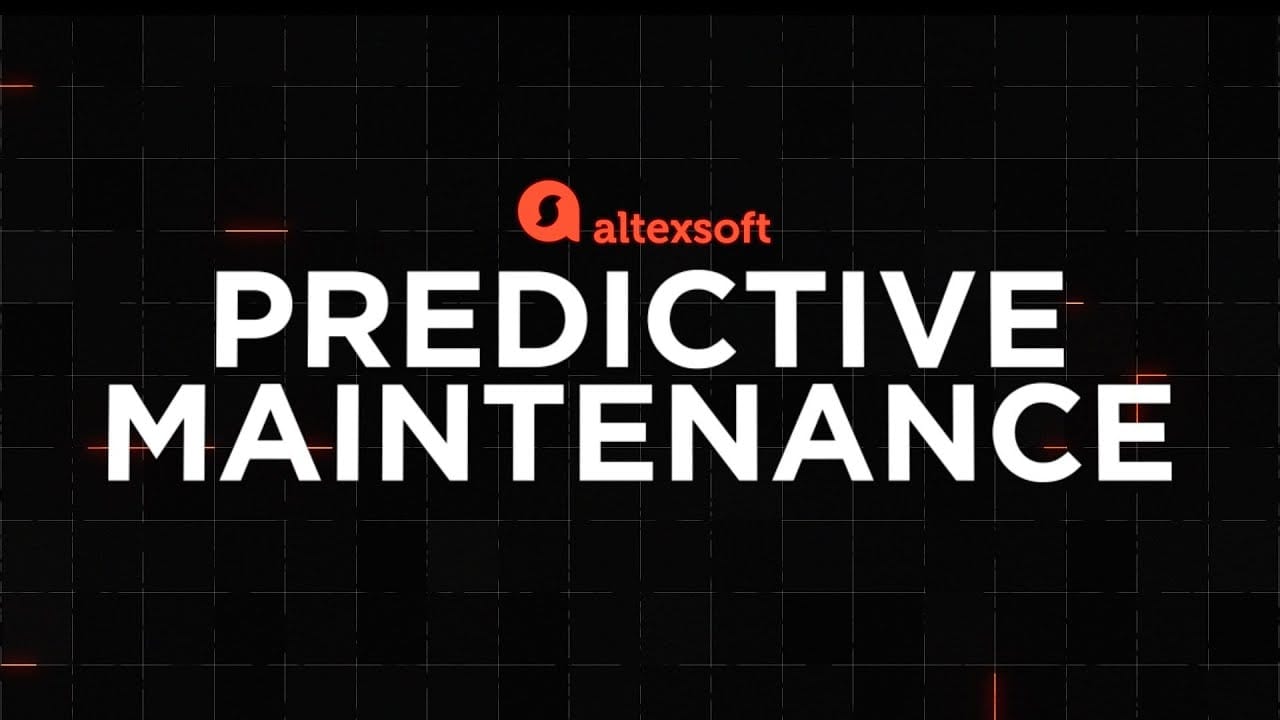In 2018, the team at AltexSoft created the first version of the Travel Technology Providers Landscape. Through the years, this infographic grew to include over 1500 companies in 13 categories from aviation and hospitality technology companies to business travel providers, OTAs, travel payment providers, and more. While we do plan to make it even bigger, we also want to narrow our focus a bit and create separate infographics for the largest sectors in the travel tech sphere. Commercial aviation was our first choice.
So we proudly present to you the Aviation Technology Providers Landscape. It includes players in these categories:
- Aggregators & consolidators
- Airline operations
- CRS & PSS providers
- Flight data providers
- Pricing & revenue management providers
- Retailing providers
Disclaimers:
- Please note that the providers have been assigned to specific categories, but they may belong to multiple categories, as their services can be represented in various ways.
- Whenever a company owns several products but markets them separately, we include them all, e.g., both Amadeus Altea and Navitaire.
- We tried our best to create a comprehensive industry landscape and are determined to update it continuously. So if you don’t see your travel business in the infographic, please let us know by emailing marketing@altexsoft.com, so we can include it in the next iteration.
How to use the infographic:
- Click on the image to open it in a new tab.
- Left-click on the Download Infographic button in the upper right corner to access the full version of the landscape.
- To explore the providers directly, you can use a spreadsheet at the end of the page where the companies are grouped by categories and alphabetically with links to their websites.

Aviation technology providers landscape 2025
You are also free to read our transcript, decoding the categories in more detail.
Transcript – What’s on the infographic?
Currently, we’ve identified 6 company categories in the aviation technology landscape.
Aggregators and consolidators
This section outlines platforms that consolidate airline offerings, helping travel sellers access a wide range of air content through a single integration.
Global distribution systems (GDSs). Amadeus, Sabre, and Travelport are the main aggregators in the travel industry, offering the most extensive coverage of the airfare market. Low-cost carriers are the only category that doesn’t rely heavily on these three.


Amadeus vs Travelport vs Sabre: Explaining Main Global Distribution Systems
Flight aggregators. These platforms collect airfares and availability data from multiple airlines – both full-service and low-cost carriers – and provide it to OTAs, TMCs, and metasearch engines. Leading players include Travelfusion, TPConnects, Aaron Group, Verteil, and more. With the rise of IATA’s New Distribution Capability (NDC), aggregators enable travel sellers to access NDC content without building separate integrations with each airline.
Air consolidators. Air consolidators are wholesalers that purchase airline tickets in bulk – typically at discounted or unpublished fares – and resell them to travel agents. The main difference between aggregators and air consolidators is that the former sells airline content access to non-IATA travel agencies. Notable examples include Mondee, Picasso Travel, and Centrav.
Read our article on choosing flight aggregators here.
Airline operations
This section outlines technologies that support the planning, management, and optimization of day-to-day airline activities.
Flight planning systems. These tools help airlines calculate optimal flight routes, fuel usage, and operational costs while ensuring regulatory compliance. Solutions such as Lido by Lufthansa Systems, NAVBLUE, and Jeppesen are widely used by carriers for dispatch and route optimization.
Crew management systems. Airlines rely on crew planning software to schedule and manage pilot and cabin crew rosters, track duty hours, and handle disruptions. Providers like AIMS, Flightscape by CAE, and Lufthansa Systems' NetLine/Crew are key players in this area.
Ops control and disruption management. Operations control systems monitor real-time flight operations and help airlines respond to delays, cancellations, and irregular operations. Tools such as SITA Mission Watch and Laminaar ARMS offer centralized control over fleet status and recovery scenarios.
Load and turnaround management. These systems help optimize aircraft loading, weight and balance, and ground handling tasks during aircraft turnaround. Products like Lufthansa Systems’ NetLine/Load and Damarel are examples of solutions used to minimize ground time and improve on-time performance.
Maintenance and engineering systems. MRO (Maintenance, Repair, and Overhaul) solutions track aircraft health, schedule maintenance events, and ensure regulatory compliance. Companies such as AMOS by Swiss AviationSoftware, Ramco Aviation, Trax, and Veryon provide comprehensive platforms for technical operations.
CRS and PSS providers
This section outlines systems that form the technological backbone of airline reservations, inventory, and passenger management.
A PSS is the core software suite used by airlines to manage reservations, inventory, and departure control. Leading products include Amadeus Altéa, SabreSonic, and Navitaire (also owned by Amadeus). These platforms support functions such as booking, ticketing, fare management, and check-in, and are critical for both customer experience and operational efficiency.
Often used interchangeably with PSS, CRS specifically refers to the inventory and booking engine component within the broader PSS architecture.
Many solutions such as GO7 or HITIT offer both CRS and PSS functionalities.
Flight data providers
This section outlines companies that aggregate, process, and deliver flight-related data for various travel and aviation use cases, from real-time tracking to historical analytics.
Flight tracking and status data. These providers deliver real-time information on flight departures, arrivals, delays, and aircraft positions. They source data from airline systems and airport feeds. Key players include FlightAware, FlightRadar24, and OpenSky Network, commonly used by OTAs, airports, and operations teams.
Schedules and timetables. Companies like OAG and Cirium maintain global databases of airline schedules and planned operations. This data is essential for itinerary building, route analysis, and network planning, and is often used by metasearch engines, GDSs, and airline planners.
Operational performance data. Providers such as Cirium and FlightGlobal offer analytics on historical on-time performance, cancellation rates, and route profitability. These insights support benchmarking, airline KPIs, and travel management reporting.
Aviation databases and APIs. Platforms like Aviowiki, Aviation Edge, and AeroDataBox provide structured data on aircraft, airlines, airports, and routes through developer-friendly APIs. These tools are used in both consumer-facing apps and B2B aviation software.
Pricing & revenue management providers
This section outlines solutions that help airlines optimize fares, manage availability, and maximize revenue throughout channels and customer segments.
Revenue management systems (RMS). Revenue management platforms analyze booking patterns, demand forecasts, and competitive pricing to optimize seat inventory and fare classes. Leading providers include PROS, Sabre Revenue Optimizer, and Amadeus Revenue Management. These systems are essential for full-service carriers and increasingly adopted by hybrid and low-cost airlines.
Dynamic pricing engines. Unlike traditional RMS tools that rely on fixed fare buckets, dynamic pricing solutions adjust fares in real time based on demand, customer behavior, and market signals. Players like Fetcherr and AirGain by RateGain offer next-gen pricing tools designed to increase yield and adapt quickly to market shifts.
Retailing platforms
This section outlines solutions that support modern airline retailing, enabling dynamic offer creation, personalized pricing, ancillary merchandising, and seamless end-to-end order management. These platforms are built to support NDC and ONE Order standards and help airlines sell more like eCommerce retailers on both direct and indirect channels.


New Distribution Capability: How NDC Boosts Airline Retailing
Click to see our massive infographic consolidating all NDC capabilities of top 75 airlines.
Emerging trends and predictions
The aviation technology landscape is evolving rapidly, driven by innovations across operations, distribution, retailing, and customer experience. Here are some key trends shaping the industry today and predictions for the near future.
Widespread adoption of NDC. Airlines and technology providers are steadily transitioning to NDC and ONE Order standards. These frameworks enable richer, personalized offers, streamlined order management, and improved retailing capabilities. We expect more legacy systems to be modernized or replaced with modular, API-first solutions becoming the norm.
Data-driven decision making and AI integration. Artificial intelligence and machine learning are transforming revenue management, flight operations, predictive maintenance, and customer personalization. AI-powered dynamic pricing, demand forecasting, and disruption management systems will become standard, improving efficiency and passenger satisfaction.


What is Predictive Maintenance?
End-to-end digital retailing. Airlines are evolving from selling static tickets to delivering fully personalized travel experiences, including ancillaries, bundled offers, and loyalty benefits. Retailing platforms that integrate offer management, merchandising, and payment orchestration will dominate, enabling airlines to compete with digital-native companies.
Real-time operational intelligence. Integration of real-time flight data, crew management, weather, and airport systems enables proactive disruption management and optimized resource allocation. This holistic operational view will reduce delays and improve passenger experience.

Maryna is a passionate writer with a talent for simplifying complex topics for readers of all backgrounds. With 7 years of experience writing about travel technology, she is well-versed in the field. Outside of her professional writing, she enjoys reading, video games, and fashion.
Want to write an article for our blog? Read our requirements and guidelines to become a contributor.

